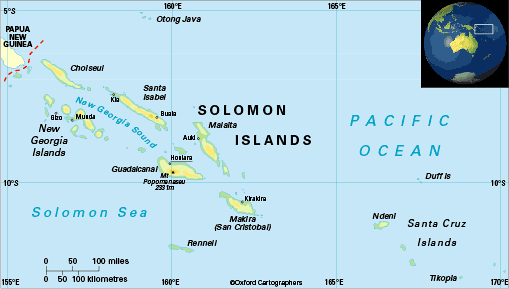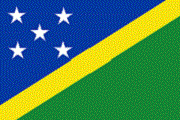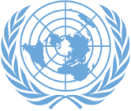
Location
Forming a scattered archipelago of mountainous islands and low-lying coral atolls, the Solomon Islands stretches about 900 miles in the south-easterly direction from the Shortlands Islands to the Santa Cruz islands. There are six major islands, Choisuel, Guadacanal, Malaita, Makira, New Georgia and Santa Isabel and approximately 992 small islands, atolls and reefs. The archipelago covers an area of 249,000 square nautical miles while the land area is 10,938 sq. miles (28,466 sq. km). The larger islands are characterized by thickly-forested mountain ranges intersected by deep, narrow valleys.
Climate
The climate is tropical, though temperatures are rarely extreme due to cooling winds blowing off the surrounding seas. Daytime temperatures normally range from 23 to 31 degrees Celsius (74-87 degrees Fahrenheit). There are two “seasons” during the year, one the dry and cool (April to October) which is the season of the south east trade winds and the wet and warm season (November to March) which brings higher temperatures and rainfall. All islands receive generous amount of rainfall averaging 3000 to 3500 mm yearly.
Population
523, 617
People
Melanesian – 93%
Polynesian – 4%
Micronesian – 1.5%
Other – 1.5% (European/Chinese/other)
Language
English is the official language, but Solomon Islands pijin is the lingua franca. There are over 80 different local languages plus dialects.
Religion
About 95% of the population is Christian. The principal religions are:
Church of Melanesia (Anglican) 29%
Roman Catholic 19%
South Seas Evangelical Church 17%
United Church (Methodist) 11%
Seventh Day Adventist 10%
More recently: Baha’i Faith, Jehovah’s Witness, Assembly of God and the Baptist Church.
Culture
Communal, familial and clan ties remain very strong in Solomon Islands. Most people consider themselves to be part of an immediate family of 200 and can trace back their ancestors at least ten generation. The Pijin word “wantok” – which derives from “one talk” meaning people from the same language group – is used to indicate blood relatives in the extended family.
Government
Solomon Islands achieved internal self-government in 1976 and became independent in July 1978. The country’s system of Government is a Parliamentary Democracy with a unicameral legislature. The British monarch as Head of State is represented locally by the Governor-General. Legislative power in vested in a unicameral National Parliament of 47 members, elected for a four year term. The executive authority is exercised by the Cabinet. A list of the current cabinet can be viewed here.
Provincial Assemblies
Apart from the National Government with its seat in the national capital, Honiara, Solomon Islands is divided into nine administrative areas or provinces. They are administered locally by elected Provincial Assemblies and headed by Provincial Premiers.
The nine provinces are:
Central Island Province
Choiseul Province
Guadacanal Province
Isabel Province
Makira & Ullawa Province
Malaita Province
Renell & Bellona Province
Temotu Province
Western Province
History
The origin of the present Melanesian inhabitants is uncertain. Although archaeological and linguistic evidence shows that Solomon Islands was probably settled 4,000-6,000 years ago by Neolithic people from South-East Asia. Archaeological evidence also shows that one group of people settled on islands from the Bismarcks to Polynesian and became the ancestry of all Polynesians, some eventually returning to the outlying islands of Solomon Islands.
The first documented European contact was made in 1568 by the Spanish explorer, Alvaro de Mendana. Mendana discovered alluvial gold on Guadacanal and, perhaps thinking he found the source of King Solomon’s great wealth (the Biblical King Solomon’s mine), named the islands “Isles of Solomon”. Because of Mendana’s Spanish heritage, many of the islands bear original Spanish names. After Mendana died of malaria the Spanish presence ended around 1606. The islands were neglected from the rest of the world until the mid nineteenth century, except for the occasional trading ships that sailed through and the Catholic & Anglican missionaries that were trying to establish themselves on the islands.
In 1893 the islands became a British protectorate and were officially known as British Solomon Islands Protectorate. A British resident commissioner had to oversee the establishment and maintenance of law and order; stop so called blackbirding (enforced recruitment & exportation of human labour to Queensland); and stop headhunting. British political, legal & justice systems were established into the local governance system.
In March 1942 the Japanese had moved into the Shortland Islands after capturing the administrative capital of New Guinea. The British had fleed Tulagi, the then capital located in the Florida Islands, before the Japanese occupied it in May. From here the Japanese moved across to Guadacanal. With the arrival of the Japanese in Guadacanal all the foreigners fled, leaving the islanders to face the Japanese alone. The Japanese treated the recruited local villagers harshly; no pay and even claimed the villager’s property, crops and food. On August 6, 1942 the Americans entered the waters around Guadacanal for their first major offensive against the Japanese in the Solomons. It was here that the America suffered one of their worst strategic sea defeats ever, near the island of Savo when attempting to recapture the territory. Before the Japanese were driven out in 1944 80,000 men in airplanes, battleships, submarines and on foot had battled on the islands. The war eventually claimed 7,000 Americans and 39,000 Japanese lives. The islanders did not participate directly in the major engagements, but they helped the Allied forces, especially as scouts or guerrillas, and received military decorations for their bravery.
After the war ended a new capital was established in Honiara around the wharves and the new American airstrip – Henderson Airfield on Guadacanal. Economic recovery was very slow since many of the wealthy expatriates did not return after the war. The British decided to begin the process of self-government after encountering nationalist movements amongst the locals, which eventually led to the establishment of the democratically elected Local Councils in 1952. Following on from this, Solomon Islands became the 37th member of the Commonwealth of Nations after achieving independence on 7 July 1978. Solomon Islands still maintains close relations with Britain and many systems such as legal and parliamentary procedures are based on the British model.
Economy
The economy is on the rebound after the devastating effects of a two year ethnic tension that almost put a halt to exports coupled with gross abuse and mismanagement of public funds with national debts accumulating to SI$2 billion in 2002. GDP fell by 14.5% on average in 2000 and 2001 with the per capita income dropping to SI$490 in 2001 from its peak of SI$1,120 in 1997. From a low inflation rate of 2% in 2001, this soared to some 13% in 2002. But this is now leveling off and stablising. Value of total exports in 2001 was estimated at US$47 million with imports at US$81 million.
Major trading partners are Australia, Malaysia, Japan, South Korea & Taiwan.
Fisheries & timber are the main sources of foreign exchange. The country also exports copra and palm oil. Tourism has great potential but will need massive government input in the development supporting structure.


